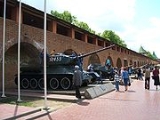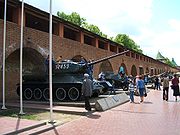
Krasnoye Sormovo Factory No. 112
Encyclopedia

Andrei Zhdanov
Andrei Alexandrovich Zhdanov was a Soviet politician.-Life:Zhdanov enlisted with the Russian Social Democratic Labour Party in 1915 and was promoted through the party ranks, becoming the All-Union Communist Party manager in Leningrad after the assassination of Sergei Kirov in 1934...
was one of the oldest shipbuilding
Shipbuilding
Shipbuilding is the construction of ships and floating vessels. It normally takes place in a specialized facility known as a shipyard. Shipbuilders, also called shipwrights, follow a specialized occupation that traces its roots to before recorded history.Shipbuilding and ship repairs, both...
factories in the Soviet Union
Soviet Union
The Soviet Union , officially the Union of Soviet Socialist Republics , was a constitutionally socialist state that existed in Eurasia between 1922 and 1991....
, located in the
Sormovsky City District
Sormovsky City District
Sormovsky District , or Sormovo , is one of the eight city districts of the city of Nizhny Novgorod, Russia. It occupies the northwestern corner of the city, adjacent to the Volga River. Population:...
of Nizhny Novgorod
Nizhny Novgorod
Nizhny Novgorod , colloquially shortened to Nizhny, is, with the population of 1,250,615, the fifth largest city in Russia, ranking after Moscow, St. Petersburg, Novosibirsk, and Yekaterinburg...
(the city was called Gorky in 1932–90).
Early history
The factory was established in 1849 by companies Nizhny Novgorod Machine Factory (Нижегородская машинная фабрика) and Volga Steam Navigation (Волжское пароходство). It was originally called the Nizhny Novgorod Machine Factory. In 1851, the factory began the construction of solid metal steamerSteamboat
A steamboat or steamship, sometimes called a steamer, is a ship in which the primary method of propulsion is steam power, typically driving propellers or paddlewheels...
s. Three years later, it developed the production of screw
Propeller
A propeller is a type of fan that transmits power by converting rotational motion into thrust. A pressure difference is produced between the forward and rear surfaces of the airfoil-shaped blade, and a fluid is accelerated behind the blade. Propeller dynamics can be modeled by both Bernoulli's...
schooner
Schooner
A schooner is a type of sailing vessel characterized by the use of fore-and-aft sails on two or more masts with the forward mast being no taller than the rear masts....
s. In 1858, the Nizhny Novgorod Machine Factory produced the first Russian steam dredger. In 1870, the first Russian open hearth furnace
Open hearth furnace
Open hearth furnaces are one of a number of kinds of furnace where excess carbon and other impurities are burnt out of the pig iron to produce steel. Since steel is difficult to manufacture due to its high melting point, normal fuels and furnaces were insufficient and the open hearth furnace was...
was built at the factory, followed by a two-decked steamship Perevorot just a year later. In 1913, it produced a dry bulk cargo ship Danilikha. The factory built 489 ships between 1849 and 1918. It also produced steam engine
Steam engine
A steam engine is a heat engine that performs mechanical work using steam as its working fluid.Steam engines are external combustion engines, where the working fluid is separate from the combustion products. Non-combustion heat sources such as solar power, nuclear power or geothermal energy may be...
s, carriage
Carriage
A carriage is a wheeled vehicle for people, usually horse-drawn; litters and sedan chairs are excluded, since they are wheelless vehicles. The carriage is especially designed for private passenger use and for comfort or elegance, though some are also used to transport goods. It may be light,...
s, steam locomotive
Steam locomotive
A steam locomotive is a railway locomotive that produces its power through a steam engine. These locomotives are fueled by burning some combustible material, usually coal, wood or oil, to produce steam in a boiler, which drives the steam engine...
s, tramcars, bridges, diesel engine
Diesel engine
A diesel engine is an internal combustion engine that uses the heat of compression to initiate ignition to burn the fuel, which is injected into the combustion chamber...
s, cannon
Cannon
A cannon is any piece of artillery that uses gunpowder or other usually explosive-based propellents to launch a projectile. Cannon vary in caliber, range, mobility, rate of fire, angle of fire, and firepower; different forms of cannon combine and balance these attributes in varying degrees,...
s, pontoon
Pontoon (boat)
A pontoon is a flotation device with buoyancy sufficient to float itself as well as a heavy load. A pontoon boat is a flattish boat that relies on pontoons to float. Pontoons may be used on boats, rafts, barges, docks, floatplanes or seaplanes. Pontoons may support a platform, creating a raft. A...
s, and projectile
Projectile
A projectile is any object projected into space by the exertion of a force. Although a thrown baseball is technically a projectile too, the term more commonly refers to a weapon....
s.
Steam locomotive builder

During 1898 - 1917, Sormovo Works built 2164 steam locomotives. During 1918 - 1935, another 1111 standard Russian gauge
Russian gauge
In railway terminology, Russian gauge refers to railway track with a gauge between 1,520 mm and . In a narrow sense as defined by Russian Railways it refers to gauge....
steam locomotives were built there. Then followed the two year period when Sormovo built 200 gauge 0-8-0 (D-h2) Kolomna Locomotive Works factory type 157 steam locomotives, after which the factory switched to making submarine diesel motors. After the German-Soviet War of 1941-45, the steam locomotive production resumed; this time on the production line was the fourth and last version of standard Soviet passenger type Su 2-6-2 (1C1-h2) steam locomotives. Overall, 411 steam locomotives were built in 1947 - 1951.
The total steam locomotive production in 1898 - 1951 was 3886 steam locomotives. (Rakov 1995)
Military production
During the Russian Civil WarRussian Civil War
The Russian Civil War was a multi-party war that occurred within the former Russian Empire after the Russian provisional government collapsed to the Soviets, under the domination of the Bolshevik party. Soviet forces first assumed power in Petrograd The Russian Civil War (1917–1923) was a...
of 1918-1920, the Nizhny Novgorod Machine Factory built armored trains, armored carriages, and weapons for the vessels of the Volga Military Flotilla. In 1920, the factory remanufactured fourteen burnt-out French Renault FT tank
Tank
A tank is a tracked, armoured fighting vehicle designed for front-line combat which combines operational mobility, tactical offensive, and defensive capabilities...
s for the Red Army
Red Army
The Workers' and Peasants' Red Army started out as the Soviet Union's revolutionary communist combat groups during the Russian Civil War of 1918-1922. It grew into the national army of the Soviet Union. By the 1930s the Red Army was among the largest armies in history.The "Red Army" name refers to...
, the Russkiy Renos, and assembled a single new copy, named 'Freedom Fighter Lenin'. In 1922, the factory changed its name by appending the adjective Krasnoye (Red) to it. During the German-Soviet War of 1941-1945, the Krasnoye Sormovo Factory produced T-34
T-34
The T-34 was a Soviet medium tank produced from 1940 to 1958. Although its armour and armament were surpassed by later tanks of the era, it has been often credited as the most effective, efficient and influential design of World War II...
medium tanks. The turret for the upgunned T-34-85 was designed here by V. Kerichev in 1943 (Zaloga 1984:166).
After the war: shipbuilding

Tanker (ship)
A tanker is a ship designed to transport liquids in bulk. Major types of tankship include the oil tanker, the chemical tanker, and the liquefied natural gas carrier.-Background:...
s, suction dredgers, and dredgers. The Krasnoye Sormovo Factory was one of the most progressive and innovative factories in the USSR. They built the first Soviet industrial device for continuous pouring of steel, developed an automated process of pouring and cutting slabs with the use of radioisotope technology, produced the first Soviet hydrofoil
Hydrofoil
A hydrofoil is a foil which operates in water. They are similar in appearance and purpose to airfoils.Hydrofoils can be artificial, such as the rudder or keel on a boat, the diving planes on a submarine, a surfboard fin, or occur naturally, as with fish fins, the flippers of aquatic mammals, the...
s (Raketa
Raketa (hydrofoil)
Raketa was the first type of hydrofoil boats commercially produced in the Soviet Union. They were manufactured from 1957 until the early 1970s...
), designed and built passenger diesel
Diesel engine
A diesel engine is an internal combustion engine that uses the heat of compression to initiate ignition to burn the fuel, which is injected into the combustion chamber...
-electric ships Lenin and Soviet Union for the Volga River Navigation company, the first high-speed passenger hovercraft
Hovercraft
A hovercraft is a craft capable of traveling over surfaces while supported by a cushion of slow moving, high-pressure air which is ejected against the surface below and contained within a "skirt." Although supported by air, a hovercraft is not considered an aircraft.Hovercraft are used throughout...
Sormovich, a few diesel-electric railroad ferries
Train ferry
A train ferry is a ship designed to carry railway vehicles. Typically, one level of the ship is fitted with railway tracks, and the vessel has a door at the front and/or rear to give access to the wharves. In the United States, train ferries are sometimes referred to as "car ferries", as...
for the Baku
Baku
Baku , sometimes spelled as Baki or Bakou, is the capital and largest city of Azerbaijan, as well as the largest city on the Caspian Sea and of the Caucasus region. It is located on the southern shore of the Absheron Peninsula, which projects into the Caspian Sea. The city consists of two principal...
-Krasnovodsk
Türkmenbasy, Turkmenistan
Türkmenbaşy , formerly known as Krasnovodsk and, more properly, Kyzyl-Su, is a city in Balkan Province in Turkmenistan, on the Krasnovodsk Gulf of the Caspian Sea. It is located at latitude 40.0231 North; longitude 52.9697 East, at an altitude of 27 meters. The population was 86,800, mostly...
route, and a unique 250-tonne double-hulled floating crane
Crane (machine)
A crane is a type of machine, generally equipped with a hoist, wire ropes or chains, and sheaves, that can be used both to lift and lower materials and to move them horizontally. It uses one or more simple machines to create mechanical advantage and thus move loads beyond the normal capability of...
Kyor-Ogly.
The Krasnoye Sormovo Factory was awarded two Orders of Lenin (1943, 1949), Order of the October Revolution
Order of the October Revolution
The Order of the October Revolution was instituted on October 31, 1967, in time for the 50th anniversary of the October Revolution. It was awarded to individuals or groups for services furthering communism or the state, or in enhancing the defenses of the Soviet Union, military and civil...
(1970), Order of the Patriotic War
Order of the Patriotic War
The Order of the Patriotic War is a Soviet military decoration that was awarded to all soldiers in the Soviet armed forces, security troops, and to partisans for heroic deeds during the German-Soviet War, known by the former-Soviet Union as the Great Patriotic War.- History :The Order was...
(1 Class, 1945), and Order of the Red Banner of Labor (1939). The factory exists to this day and is now a part of the United Machinebuilding Factories Corporation (Корпорация Объединенные Машиностроительные заводы)

